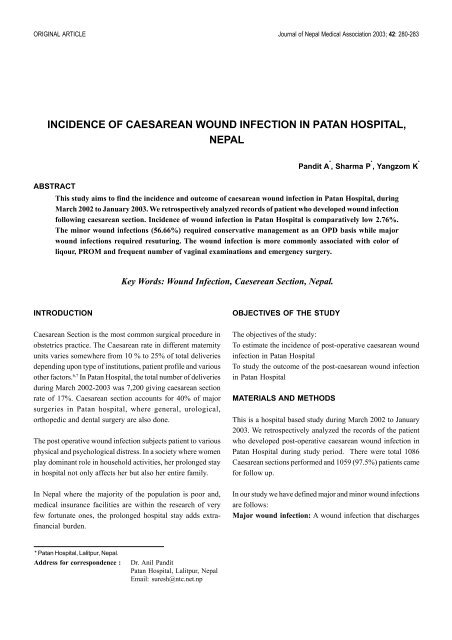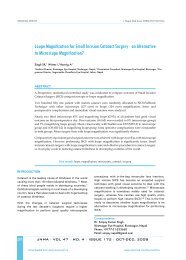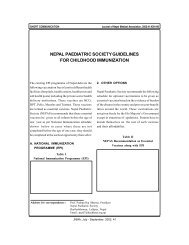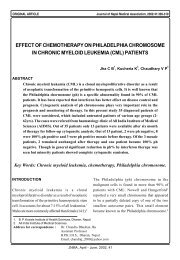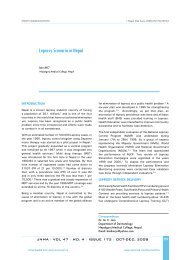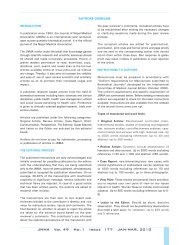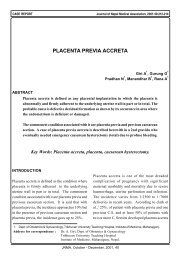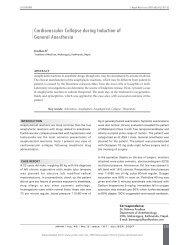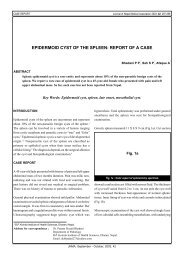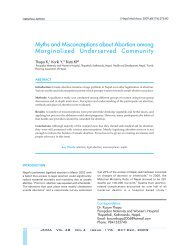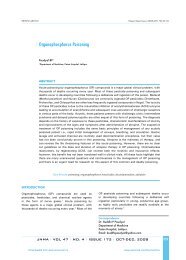incidence of caesarean wound infection in patan hospital, nepal
incidence of caesarean wound infection in patan hospital, nepal
incidence of caesarean wound infection in patan hospital, nepal
Create successful ePaper yourself
Turn your PDF publications into a flip-book with our unique Google optimized e-Paper software.
ORIGINAL ARTICLE Journal <strong>of</strong> Nepal Medical Association 2003; 42: 280-283<br />
INCIDENCE OF CAESAREAN WOUND INFECTION IN PATAN HOSPITAL,<br />
NEPAL<br />
ABSTRACT<br />
Pandit A * , Sharma P * , Yangzom K *<br />
This study aims to f<strong>in</strong>d the <strong><strong>in</strong>cidence</strong> and outcome <strong>of</strong> <strong>caesarean</strong> <strong>wound</strong> <strong><strong>in</strong>fection</strong> <strong>in</strong> Patan Hospital, dur<strong>in</strong>g<br />
March 2002 to January 2003. We retrospectively analyzed records <strong>of</strong> patient who developed <strong>wound</strong> <strong><strong>in</strong>fection</strong><br />
follow<strong>in</strong>g <strong>caesarean</strong> section. Incidence <strong>of</strong> <strong>wound</strong> <strong><strong>in</strong>fection</strong> <strong>in</strong> Patan Hospital is comparatively low 2.76%.<br />
The m<strong>in</strong>or <strong>wound</strong> <strong><strong>in</strong>fection</strong>s (56.66%) required conservative management as an OPD basis while major<br />
<strong>wound</strong> <strong><strong>in</strong>fection</strong>s required resutur<strong>in</strong>g. The <strong>wound</strong> <strong><strong>in</strong>fection</strong> is more commonly associated with color <strong>of</strong><br />
liqour, PROM and frequent number <strong>of</strong> vag<strong>in</strong>al exam<strong>in</strong>ations and emergency surgery.<br />
Key Words: Wound Infection, Caeserean Section, Nepal.<br />
INTRODUCTION<br />
Caesarean Section is the most common surgical procedure <strong>in</strong><br />
obstetrics practice. The Caesarean rate <strong>in</strong> different maternity<br />
units varies somewhere from 10 % to 25% <strong>of</strong> total deliveries<br />
depend<strong>in</strong>g upon type <strong>of</strong> <strong>in</strong>stitutions, patient pr<strong>of</strong>ile and various<br />
other factors. 6,7 In Patan Hospital, the total number <strong>of</strong> deliveries<br />
dur<strong>in</strong>g March 2002-2003 was 7,200 giv<strong>in</strong>g <strong>caesarean</strong> section<br />
rate <strong>of</strong> 17%. Caesarean section accounts for 40% <strong>of</strong> major<br />
surgeries <strong>in</strong> Patan <strong>hospital</strong>, where general, urological,<br />
orthopedic and dental surgery are also done.<br />
The post operative <strong>wound</strong> <strong><strong>in</strong>fection</strong> subjects patient to various<br />
physical and psychological distress. In a society where women<br />
play dom<strong>in</strong>ant role <strong>in</strong> household activities, her prolonged stay<br />
<strong>in</strong> <strong>hospital</strong> not only affects her but also her entire family.<br />
In Nepal where the majority <strong>of</strong> the population is poor and,<br />
medical <strong>in</strong>surance facilities are with<strong>in</strong> the research <strong>of</strong> very<br />
few fortunate ones, the prolonged <strong>hospital</strong> stay adds extraf<strong>in</strong>ancial<br />
burden.<br />
OBJECTIVES OF THE STUDY<br />
The objectives <strong>of</strong> the study:<br />
To estimate the <strong><strong>in</strong>cidence</strong> <strong>of</strong> post-operative <strong>caesarean</strong> <strong>wound</strong><br />
<strong><strong>in</strong>fection</strong> <strong>in</strong> Patan Hospital<br />
To study the outcome <strong>of</strong> the post-<strong>caesarean</strong> <strong>wound</strong> <strong><strong>in</strong>fection</strong><br />
<strong>in</strong> Patan Hospital<br />
MATERIALS AND METHODS<br />
This is a <strong>hospital</strong> based study dur<strong>in</strong>g March 2002 to January<br />
2003. We retrospectively analyzed the records <strong>of</strong> the patient<br />
who developed post-operative <strong>caesarean</strong> <strong>wound</strong> <strong><strong>in</strong>fection</strong> <strong>in</strong><br />
Patan Hospital dur<strong>in</strong>g study period. There were total 1086<br />
Caesarean sections performed and 1059 (97.5%) patients came<br />
for follow up.<br />
In our study we have def<strong>in</strong>ed major and m<strong>in</strong>or <strong>wound</strong> <strong><strong>in</strong>fection</strong>s<br />
are follows:<br />
Major <strong>wound</strong> <strong><strong>in</strong>fection</strong>: A <strong>wound</strong> <strong><strong>in</strong>fection</strong> that discharges<br />
* Patan Hospital, Lalitpur, Nepal.<br />
Address for correspondence :<br />
Dr. Anil Pandit<br />
Patan Hospital, Lalitpur, Nepal<br />
Email: suresh@ntc.net.np<br />
JNMA, September - October, 2003, 42
281 Pandit et al. Incidence <strong>of</strong> Cesarean Wound Infection <strong>in</strong> Patan Hospital, Nepal<br />
pus and may require secondary procedure. 8<br />
M<strong>in</strong>or <strong>wound</strong> <strong><strong>in</strong>fection</strong>: A <strong>wound</strong> <strong><strong>in</strong>fection</strong> that discharges<br />
pus but doesn't show any systemic response, discomfort or affect<br />
<strong>hospital</strong> stay. 8<br />
In Patan Hospital, patients are discharged on fourth postoperative<br />
day and first post-operative day is counted the day<br />
follow<strong>in</strong>g surgery irrespective <strong>of</strong> time <strong>of</strong> surgery. The data were<br />
collected dur<strong>in</strong>g the morn<strong>in</strong>g rounds from those patients who<br />
developed <strong>wound</strong> <strong><strong>in</strong>fection</strong> dur<strong>in</strong>g <strong>hospital</strong> stay. The patients<br />
who developed <strong>wound</strong> <strong><strong>in</strong>fection</strong> follow<strong>in</strong>g discharge from the<br />
<strong>hospital</strong> were picked up dur<strong>in</strong>g follow up. Although the patients<br />
are advised to come for follow up after one week to Patan<br />
Hospital out patient department, we might have missed few<br />
cases who, didn't report to OPD and went to other private<br />
practitioners.<br />
Number <strong>of</strong> per vag<strong>in</strong>al exam<strong>in</strong>ation: In 14 cases, p v<br />
exam<strong>in</strong>ation was done less 2 times. But these cases were<br />
either associated with premature rupture <strong>of</strong> membrane or<br />
placenta previa where vag<strong>in</strong>al exam<strong>in</strong>ations are restricted<br />
or even contra-<strong>in</strong>dicated. In 12 cases, p v exam<strong>in</strong>ation was<br />
done 2-5 times and <strong>in</strong> four case p v exam<strong>in</strong>ation was done<br />
more than 5 times.<br />
Fig. 2 : Per Vag<strong>in</strong>al Exam<strong>in</strong>ation<br />
We estimated the <strong><strong>in</strong>cidence</strong> and outcome <strong>of</strong> post-operative<br />
<strong>caesarean</strong> section <strong>in</strong> relation to type <strong>of</strong> <strong><strong>in</strong>fection</strong>, type <strong>of</strong><br />
management, duration <strong>of</strong> prolonged <strong>hospital</strong> stay. We also<br />
looked <strong>in</strong>to the <strong><strong>in</strong>cidence</strong> <strong>of</strong> <strong>wound</strong> <strong><strong>in</strong>fection</strong> with age,<br />
Premature rupture <strong>of</strong> membrane (PROM), number <strong>of</strong> vag<strong>in</strong>al<br />
exam<strong>in</strong>ation, color <strong>of</strong> liquor, <strong>in</strong>dication <strong>of</strong> surgery and<br />
experience <strong>of</strong> the surgeons.<br />
RESULTS<br />
Incidence: There were total <strong>of</strong> 1086 <strong>caesarean</strong> section dur<strong>in</strong>g<br />
study period. Out <strong>of</strong> which 30 patients developed either major<br />
or m<strong>in</strong>or <strong>wound</strong> <strong><strong>in</strong>fection</strong> giv<strong>in</strong>g an <strong><strong>in</strong>cidence</strong> <strong>of</strong> 2.76 %.<br />
PROM: Out <strong>of</strong> 30 cases, 10 (33.33%) had premature rupture<br />
<strong>of</strong> membrane. 7 cases had rupture <strong>of</strong> membrane more than 24<br />
hours. 2 cases had more than 6 hours. In 1 case it was only 3<br />
hours duration. Out 7 who had rupture <strong>of</strong> membrane more<br />
than 24 hours, 4 developed major and 3 developed m<strong>in</strong>or<br />
<strong>wound</strong> <strong><strong>in</strong>fection</strong>s.<br />
LIQUOR COLOR: There were 18 cases with clear, 9 cases<br />
with moderate, 2 cases with light and 1 case with thick sta<strong>in</strong><strong>in</strong>g<br />
<strong>of</strong> liquor. Out <strong>of</strong> 18 cases with clear liquor, 6 cases had either<br />
premature rupture <strong>of</strong> membrane more than 24 hours or more<br />
than 3 number <strong>of</strong> p v exam<strong>in</strong>ation.<br />
Type <strong>of</strong> <strong>wound</strong> <strong><strong>in</strong>fection</strong>: There were 13 (43.33%) major and<br />
17 (56.66%) m<strong>in</strong>or <strong>wound</strong> <strong><strong>in</strong>fection</strong>s.<br />
Type <strong>of</strong> Management: 18 cases were managed conservatively<br />
while 12 required resutur<strong>in</strong>g.<br />
Fig. 3 : Duration <strong>of</strong> Hospital Stay<br />
Fig. 1 : Premature rupture <strong>of</strong><br />
membrane<br />
8<br />
7<br />
6<br />
5<br />
4<br />
3<br />
2<br />
1<br />
0<br />
Major<br />
M<strong>in</strong>or<br />
> 24 hours<br />
12-24 hours<br />
< 12 hours<br />
JNMA, September - October, 2003, 42
Pandit et al. Incidence <strong>of</strong> Cesarean Wound Infection <strong>in</strong> Patan Hospital, Nepal 282<br />
Duration <strong>of</strong> Hospital Stay: In 10 cases (33.33%) <strong>hospital</strong><br />
stay was prolonged. In 5 cases <strong>hospital</strong> stay was prolonged<br />
more than 10 days, <strong>in</strong> 3 cases between 5-10 days and <strong>in</strong> 2<br />
cases less than 5 days.<br />
Indication <strong>of</strong> surgery: In 26 cases the <strong>in</strong>dication was<br />
emergency while 4 cases were elective.<br />
Level <strong>of</strong> Surgeons:<br />
Table I shows with <strong>in</strong>creas<strong>in</strong>g level <strong>of</strong> experience decreas<strong>in</strong>g<br />
rate <strong>of</strong> <strong><strong>in</strong>fection</strong>. Incidence be<strong>in</strong>g highest among residents<br />
(3.79%) and lowest among consultants ( 0.84%).<br />
Relation <strong>of</strong> Major <strong>wound</strong> <strong><strong>in</strong>fection</strong> with liquor colour,<br />
PROM, and number <strong>of</strong> pv exam<strong>in</strong>ation<br />
There were 5 cases with moderate meconium and 8 cases <strong>of</strong><br />
clear liquor who developed major <strong>wound</strong> <strong><strong>in</strong>fection</strong>. Those 8<br />
cases with clear liquor, 6 cases either PROM more than 24<br />
hours or more number <strong>of</strong> p v exam<strong>in</strong>ation.<br />
Thus major <strong>wound</strong> which required resutur<strong>in</strong>g had either<br />
moderate meconium or PROM > 24 hour or more number <strong>of</strong><br />
pv exam<strong>in</strong>ation done.<br />
Relation <strong>of</strong> M<strong>in</strong>or <strong>wound</strong> <strong><strong>in</strong>fection</strong> with liquor colour,<br />
PROM and number <strong>of</strong> pv exam<strong>in</strong>ation.<br />
Out 17 cases <strong>of</strong> m<strong>in</strong>or <strong>wound</strong> <strong><strong>in</strong>fection</strong>, 4 cases had moderate,<br />
3 cases had light and 1 case had thick meconium. In 3 cases<br />
PROM more than 24 hours, 2 cases PROM more than 12 hours<br />
and <strong>in</strong> 1 cases less than 12 hours. In 5 cases pv exam<strong>in</strong>ation<br />
was done more than 3 times. In case p v was done even 7<br />
times, <strong>in</strong> 2 cases 6 times and <strong>in</strong> another 2 cases 4 times.<br />
Thus m<strong>in</strong>or <strong>wound</strong> <strong><strong>in</strong>fection</strong>s had either light to thick<br />
meconium, PROM and more number <strong>of</strong> pv exam<strong>in</strong>ation.<br />
Organisms isolated: In only 5 cases, culture grew organisms.<br />
Out <strong>of</strong> which <strong>in</strong> 3 cases coagulase positive staphyloccocus, 2<br />
cases enterobacter and 1 case bacillus species were isolated.<br />
DISCUSSION<br />
Several studies are conducted to estimate the <strong><strong>in</strong>cidence</strong> <strong>of</strong> postoperative<br />
<strong>wound</strong> <strong><strong>in</strong>fection</strong> <strong>in</strong> various part <strong>of</strong> world rang<strong>in</strong>g<br />
from < 2 % to 10%. A multi-centric study done <strong>in</strong> United<br />
K<strong>in</strong>gdom, West Yorkshires, f<strong>in</strong>ds the <strong><strong>in</strong>cidence</strong> <strong>of</strong> 6.2 % with<br />
the use <strong>of</strong> prophylactic antibioitcs. 5 Another study done <strong>in</strong><br />
Texas USA, found the <strong><strong>in</strong>cidence</strong> to be 7.8%. 4 It has also found<br />
that the subcutaneous sk<strong>in</strong> thickness appears to be significant<br />
risk factor associated with abdom<strong>in</strong>al <strong>wound</strong> <strong><strong>in</strong>fection</strong> after<br />
<strong>caesarean</strong> delivery. 4 In Patan Hospital the <strong><strong>in</strong>cidence</strong> <strong>of</strong> <strong>wound</strong><br />
<strong><strong>in</strong>fection</strong> is comparatively very low (2.76%). This may be<br />
attributed to the fact that overall Nepalese population is less<br />
obese than western population although we didn't measure<br />
body mass <strong>in</strong>dex <strong>in</strong> our study.<br />
Martens M G and associates. Texas 1995 have found that<br />
post <strong>caesarean</strong> <strong>wound</strong> <strong><strong>in</strong>fection</strong> is associated with rupture <strong>of</strong><br />
membrane as less than 6 hour, emergency operation and morbid<br />
obesity. 3 In our study 7 cases had rupture <strong>of</strong> membrane for<br />
more than 24 hours while 2 had more than 6 hours and 1 had<br />
3 hours.<br />
Labet A and et al , Mount S<strong>in</strong>ai, New York, March 2003 have<br />
found that meconium enhances the growth <strong>of</strong> per<strong>in</strong>atal<br />
pathogens and can occur as early as 6 hours <strong>of</strong> bacterial<br />
<strong>in</strong>teraction with meconium 2 Another study has found that<br />
even light meconium enhances the growth <strong>of</strong> Group B<br />
streptoccocus. 1<br />
In our study 5 cases <strong>of</strong> major <strong>wound</strong> <strong><strong>in</strong>fection</strong> had moderate<br />
meconium while 8 cases <strong>of</strong> m<strong>in</strong>or <strong>wound</strong> <strong><strong>in</strong>fection</strong> had light<br />
to thick meconium.<br />
CONCLUSION<br />
The <strong><strong>in</strong>cidence</strong> <strong>of</strong> post <strong>caesarean</strong> <strong>wound</strong> <strong><strong>in</strong>fection</strong> <strong>in</strong> Patan<br />
Hospital is comparatively low 2.76% and they were m<strong>in</strong>or<br />
<strong>wound</strong> <strong><strong>in</strong>fection</strong> (56.66%) managed conservatively as an OPD<br />
basis while major <strong>wound</strong> <strong><strong>in</strong>fection</strong>s required resutur<strong>in</strong>g.<br />
JNMA, September - October, 2003, 42


